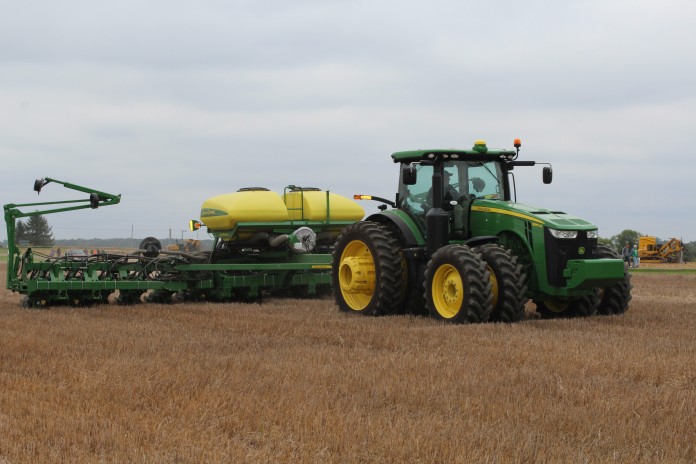Karen Carpenter sang it many years ago: “Rainy days and Mondays always get me down.” She knew about being down — she lost her life to an eating disorder in her prime.
Today, I think of that song as I talk to a farmer friend from extreme northeast Ohio who is trying to not be depressed about the current weather. He told me he was looking for things to do while the ground dried up, and the ground was already too wet to get to the piece of fence he wanted to fix.
Wet in Ohio
In northern Trumbull and southern Ashtabula Counties, a swath of pretty good ag production surrounded by cities, farmers regularly fight to get enough sunshine to dry out the fields and grow the crops.
This year is starting out with wet weather that has farmers discouraged. A week ago, they agreed that the U.S. Department of Agriculture Crop Progress Report was correct with 8% of the corn planted, although none of it was here. This week, the report from May 5 was 22% planted, and still none of it was in this area.
With an inch of rain the evening of May 5, the next two days forecast for more rain and ponds in the fields, we are seeing a demonstration of what scattered rain in the forecast means.
Enough of the scattered areas did not get the rain over the Midwest that we got; the national crop is up to 40% planted, slightly above the 39% average. Last week, the nation was at 24% planted. We are now a week into May, and we are remembering that the benchmark is for 75% of the crop to be planted by May 15. We have higher-than-ever capacity to plant and no real need to sleep until winter, so it could get really busy with an eight-to-14-day forecast for a dryer than normal Eastern Corn Belt. Let’s hope for that!
Unfortunately, the current fast pace of planting on the average is credited with being the force behind the market going in the tank May 5. July corn was down almost 15 cents, and July soybean futures were off over 12 cents.
The traders are always predisposed to believe in a big crop until there is proof to believe in something else. With our jump in acres projected to be high, at 91.5 million acres, and a trend-line yield of 183 bushels per acre, the traders that run the markets are still expecting a third crop over 15 billion bushels and probably a record.
Soybeans
Soybeans, meanwhile, are also being planted at a fast pace. Ohio has planted 25% of the crop, up from 10% a week ago. The average is just 13%, so some farmers were planting soybeans instead of corn this last week. The nation has planted 30%, up from 18% last week. That is well ahead of the 29% average.
Since the yield advantage to early planting of soybeans is being more recognized, if we have good growing weather in May, the early planting of soybeans will help replace some of the reduced planned acres of soybeans. If recognized by the market, this will contribute to lower prices for soybeans.
Old versus new. It is interesting to note that there is divergence between the old and new crops of the major commodities. That is, the old crop volatility is much higher than the new crop volatility. This does not make sense since we are currently trading the weather for the new crop, but it is how the market works. The biggest open interest is almost always in the nearby, in this case, July contract.
Some of the volatility in the old crop may be because the farmers may hold more of the crops than normal. If it gets later in the year and the farmers are holding the grain, the cash bids do not improve as much as expected, since the market knows the corn and beans “have to come to town” eventually.
Exports
The later in the year it becomes, the greater importance may be put on exports. We are comfortable with corn and soybean supplies, yet there are indications that we could have enough demand to tighten up the balance sheet. Corn exports, especially, have been strong, maybe because they have been cheap or maybe because of some concerns over the tariff wars.
This week, we loaded out 63.3 million bushels of corn, at the high end of trader guesses. Our accumulated exports have reached 1.674 billion bushels, which is well ahead of last year’s pace. We loaded out 11.9 million bushels of soybeans, which was at the low end of trade expectations, unlike the corn. We are still ahead of last year’s export pace, with 1.597 billion bushels exported. All wheat exports for the week were the worst ag commodity, with 11.4 million bushels loaded out, below the lowest trade guess. We have now exported 726.5 million bushels.
It still remains to be seen how the tariff policies of President Donald Trump will impact agriculture. It may be that we suffer with reduced exports, or we may start signing deals with other countries that mean that we have survived the short-term squeeze and will be better off for a long period of time.
In 2018, when Trump started the last trade war with China, we did not get much for soybean business that year. It is hard to tell what happens in 2025. Brazil has had a record crop, and they are the preferred origin for China. However, it is hard to predict what happens later, since this time of year they get everything they can from Brazil and Argentina.
I have read an encouraging article in the online edition of Farm Progress. In it, the writer speculates that China has developed such a large hunger for soybeans that they may have to chew through some American soybeans.
In another Farm Progress article, Cory Bratland argues that corn yields may be plateauing. This reminds me that I first heard this in 1967, at Ohio State University. The argument was that the hybridization of corn in the ‘40s and ‘50s was the first big jump in yields, and the yield curve would flatten out. It never has, and a couple of blips in the past few years have not convinced me it will.
Most of the gains have been through genetics, although a change to shallow and minimum tillage has contributed. The growth figuratively and literally in tillage and planting equipment has also contributed a lot in terms of getting more of the crop planted on time.












